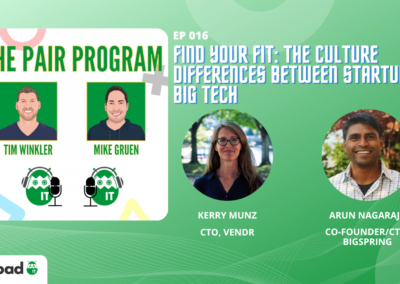Landing your dream role can feel exhilarating.
But the process can be arduous.
Is there any way to make it easier?
In this article, we share 11 tips for technical job seekers to revamp their job search process. We offer insights into how to prepare for a job search, best practices for finding the right role, and next steps after applying so you can have a smooth job search.
Table of Contents
- Identify Your “Goldilocks Job”
- Collect Essential Job Search Documents
- Update Your Online Presence
- Supercharge Your Networking Muscles
- Learn The Job Search Lingo
- Keep Track of EVERY Job That Piques Your Interest
- Reach Out to Recruiters
- Run Through Your Online Interview Checklist
- Express Interest in Learning About the Company
- Show Gratitude (Even If You Don’t Get the Role)
- Learn From Your Rejections and Keep Pushing Forward
Before You Begin Your Search…
Tip #1: Identify Your “Goldilocks Job”
With computer science and software engineering continuing to rank among the most in-demand college majors, finding the right job in tech can feel like sifting through an ever-expanding ocean of opportunities.
So, before you cast your first line, take a step back and imagine the perfect role for yourself. What daily tasks would you like to have? Which technologies do you want to work with? What points in a job description would immediately make you click the “Apply Now” button?
Jot down all of these required characteristics for your dream job. Your list should include the following criteria:
- Industry: Are you interested in IT? Fintech? Healthtech? Tech roles are increasingly prevalent in every major industry. Consider which larger problems, products, and missions interest you.
- Position: Manager or IC? Frontend or backend? Determine your ideal work responsibilities and career tracks based on your strengths.
- Compensation: It seems like engineering salaries have no ceiling, but it’s important to be realistic. Determine the minimum salary that you would need to be satisfied when you look at your paycheck. Plus, consider total compensation including equity, perks, and benefits.
- Benefits/Perks: Full health insurance coverage and a retirement investing plan like a 401(k) are essentials. But are there any other benefits that you would want your company to offer? Whether you’re looking for generous parental leave or an internet stipend for your home office, think about the benefits that are must-haves for you.
- Location: Do you prefer your work to be 100% remote? 100% in-office? Some hybrid of the two? Knowing what location you want to work in will help you vet out jobs as you search.
- Company Culture: With more companies prioritizing healthy business cultures in 2022, identify the types of company atmospheres that meet your requirements for collaboration, conduct, and diversity.
- Available Technologies: What is your preferred tech stack? Is there a coding language that you’ve always wanted to learn? Consider what technologies you would want to work with and gain exposure to in your day-to-day.
After you have crafted a complete list of characteristics for your dream role, order them by priority. It might be difficult to find a position that satisfies every requirement on your list, so being able to identify the two or three requirements that are your deal breakers will help narrow the ocean that you are going to be fishing out of.
Tip #2: Collect Essential Job Search Documents
Once you have an idea of what you’re looking for, it’s time to start gathering important application documents.
Most job descriptions detail the specific resources that you will need throughout the application process. However, having a versatile collection of reusable documents will greatly reduce the amount of time that you will spend with each individual submission.
At a minimum, we suggest having:
- An updated resume
In addition to adding any new skills or experience that you find relevant, make sure that you can easily explain any gaps in your work history.
- A link to a technical portfolio
It’s important for software engineers to establish their credibility by building a technical portfolio of skills, experience, and accomplishments. You have total control, so don’t forget to also inject it with some of your own personality and interests! Note: As an alternative to a dedicated portfolio, consider linking to any open-source projects that you contributed to on GitHub.
- A job search spreadsheet
Regardless of where you are in the application process for each company, you need a document to track every position that piques your interest (try this template). In general, it’s vital to track information on:
- Position name
- Company name
- Job Location
- Salary/Compensation
- Job listing link
- Brief description of role responsibilities
- Contact info for company POC
- Date applied
- Stage of application process
For the documents that you intend to share with your interviewers and target companies, it’s crucial that you make them easily accessible. Test all hyperlinks, double-check that your portfolio is set to public access, and print extra copies of your resume (if your interview is in-person). Showing that you’re prepared for the interview will set a strong first impression.
Pro Tip: If you need any documents or work samples from your current job, be sure to transfer them off your work computer to yourself ahead of time. Being proactive about what you need before you leave will prepare you for the job hunt and make it easier to quit your current job on good terms.
Tip #3: Update Your Online Presence
Most engineers focus their preparation efforts solely on polishing up their resumes.
But nowadays, your LinkedIn profile represents as valuable of a tool as a one-page Word document.
Spend the time to update your job title, add any relevant work experience, link to your technical portfolio or GitHub, and freshen up your profile image with a clean and genuine portrait of yourself to make your LinkedIn profile stand out from other candidates.
In particular, put some effort into revising your “About” section. This is the part of your profile that does the best job at selling you so be sure to add details on your background including your tech stack, professional skills, and any other interests or side hustles that give visitors a well-rounded image of who you are.
And don’t forget to add in some buzzwords such as “available for work,” “product,” and “jobs in tech.” Having the right keywords makes it easier for recruiters and companies to find you in their searches.
Likewise, take a minute to optimize your other social media accounts. Add “looking for work” to your GitHub, sharpen up your Slack headline, and review your personal social media accounts for any sensitive or inappropriate content. Placing importance on improving your entire online presence can make all the difference in building the right professional connections.
If you want the full deep dive into how you can best prepare for a technical job search, check out the 7-step job search checklist!
During Your Job Search…
Tip #4: Supercharge Your Networking Muscles
After you’ve amassed all the resources that you need, it’s time to start putting a face to the name.
As you begin researching for relevant roles, don’t limit yourself to just reading job descriptions and scanning company websites. Sign-up for online events and webinars on tech topics of interest and introduce yourself to the event hosts and other attendees. Networking with like-minded software developers at events is a great way to learn more about potential opportunities in the tech space as well as leave a lasting impression on people that may lead you to your dream role.
If you’re more interested in peer-to-peer networking, consider joining tech communities on LinkedIn, Facebook, and Slack. In particular, browsing the “Groups” tab on LinkedIn offers the best opportunities for building relationships with others directly related to your profession and technologies that you are passionate about.
Here are just a few of the best LinkedIn tech groups:
- Information Technology Professionals
- Technology Jobs Network
- DevOps Careers Human Resources Network
- Python Developers Community
- Angular Developers
- Women in Software Engineering
- Cloud Computing, Cybersecurity, SaaS, Data Centre, & Virtualization
- Web Developers United
It can also be advantageous to reach out and connect with people who work at the companies that you’re interested in.
Refrain from sending a connection request on LinkedIn without any context. Instead, add a note introducing yourself and expressing interest in learning more about their business. Not only will you gain a new resource of information about your target position but you will begin your relationship with the company on a positive note.
Tip #5: Learn The Job Search Lingo
Finding the right role in an ocean of opportunities is easier if you use a larger net.
When leveraging search engines and career sites for finding job openings, start by searching with the right tech keywords. Many engineers limit their search categories to just their desired industry or title but expanding your keyword usage to include technical skills and locations can help you locate roles that are searched for more infrequently.
In addition, tools like Keyword Finder and Wordtracker generate the top-ranked keywords for your selected search term to ultimately help you cast a wider net and reach the opportunities that are most relevant to you.
And remember to keep track of keywords that you use as well as the number of results for each term. Making a list of everything that you have searched so far will save you from having to scroll through your search engine history to determine which keywords have already been used.
Pro Tip: If you are struggling to find the right keyword, try plugging a more general term into your search engine and scan over some of the articles that appear near the top. It’s likely that these articles have links to company sites that would be of interest to you.
Tip #6: Keep Track of EVERY Job That Piques Your Interest
Whether you check all the boxes or only match one or two requirements in the job description, make a list of every job opening that you find appealing. Most requirements in job descriptions are just suggestions. Recruiters and hiring managers are still likely to consider you as long as you show them that you have the skills to succeed in that role.
Nevertheless, you’ll still need to clearly express why you are still a good fit even if you aren’t a 100% match for the description.
Likewise, if your preferred role at your target company has already been filled, take note of any similar job openings at the same company. If you communicate your intentions upfront and your boss views you as a valued addition to the team, they will likely allow you to explore your preferred role and its responsibilities during your tenure at the organization.
Note: Relevant internships and contract work are only worthwhile for reaching your preferred role at a company if there is an assurance that you can transition into a full-time role after a specified period of time.
Tip #7: Reach Out to Recruiters
If you’re having trouble finding worthy options for yourself, it never hurts to ask for help!
One of the most common mistakes that technical job seekers make is assuming that recruiters are only concerned with earning a commission. While there certainly are companies that operate like this, the vast majority of recruiters keep the candidate’s best interests at heart and find great joy in helping them find the best possible role.
If you’re on LinkedIn, here are a couple of ways to signal that you’re open to working with a recruiter:
- Set your profile to “Open to Work”
- List the types of roles that you are open to in your “About” section
Taking these steps will make it easier for recruiters to find you.
Otherwise, you can always reach out directly to recruiters who work at companies that you’re interested in!
Interested in working with a recruiter? Send us your resume
After You Apply…
Tip #8: Run Through Your Online Interview Checklist
It’s official: Zoom has become the norm for hiring interviews.
As 86% of companies have admitted to conducting virtual interviews at some point during the pandemic, it’s likely that at least a portion of your technical interview process will be held over a video conferencing app.
Whether you’re preparing for a phone screen or a whiteboarding test, here’s the personal checklist that you should run through for every virtual interview:
- Do I have the documents that I need?
Don’t add extra stress to your job interview by memorizing every relevant fact about yourself. Compile all of your resumes and work sample links ahead of time and paste them in a Word document that you can reference during the interview.
Pro Tip: If you have a technical interview that you want to ace, consider making yourself a GitHub cheat sheet with notes and answers on the practice problems that you find relevant and keeping that open during the meeting.
- Do I have an appropriate camera background?
You don’t necessarily have to situate yourself in front of a blank wall. But do be mindful of anything that you choose to leave visible during the interview. You don’t want anything behind you to be distracting or give off the wrong impression.
- Is my image well-lit?
It’s unlikely that you would need a professional lighting setup for your interview, but you should still take a moment to assess the clarity of your camera image beforehand. Moving into an evenly lit room or shining more natural light on your face with a window can (literally) help frame you in a better light to your interviewer.
- Have I adjusted my computer settings?
Check if sound is coming out of the right place. Select your preferred microphone. Mute your Slack notifications. Turn your computer to “Quiet” mode. It’s easier to overcome the awkwardness at the beginning of an interview if you don’t have to battle a distracting computer at the same time.
Along with putting on professional attire and arriving a few minutes early, going over this quick virtual interview checklist will help you set the best foot forward before you even answer your first question.
Tip #9: Express Interest in Learning About the Company
Job interviews don’t have to be a one-way street.
When speaking with your interviewer, ask questions about the company’s history, product, core values, and company culture.
Not only will you get a better sense if the role is right for you but you will communicate that you are interested in the business beyond supporting your own personal welfare.
Likewise, don’t just connect with the people who you’re interviewing with! Reach out to members of your target company’s HR department as well as engineers in similar roles to the one that you are interested in. Oftentimes, you can get more honest answers about the company out of people who aren’t responsible for filling positions.
If nothing else, your thorough research about the business serves as an additional means to stand out during the interview process.
Tip #10: Show Gratitude (Even If You Don’t Get the Role)
From submitting the initial application to planning your interview answers, you put a lot of work into the application process.
But don’t forget about the work that your interviewer put in to meet with you!
Immediately following an interview, the first thing that you should do when you return to your desk is to send your interviewers a thoughtful and original “thank you” email. Simple expressions of gratitude for the time that they spent speaking with you and answering your questions may be the deciding factor when choosing between you and another engineer.
Consider adapting this email template:
Hi [Interviewer name],
Thank you so much for taking the time to meet with me today. I am grateful for the opportunity to learn more about the [Job Title] role and can’t wait to hear more about the team at [Company Name]. I’m looking forward to speaking with you further about next steps. Please don’t hesitate to contact me if you have any other questions or concerns that you would like to discuss.
Thanks again,
[First and Last Name]
If you can tell that you failed a job interview, it’s still a good practice to send your interviewers a “thank you” message for taking the time to meet with you. It’s more likely that they will keep you in mind for any future job openings if you keep your relationship with them on good terms.
Tip #11: Learn From Your Rejections and Keep Pushing Forward
Let’s face it: rejections can feel heartbreaking.
They can also serve as incredible learning opportunities.
If you maintain a good relationship with your interviewer, inquire about the reasoning behind why you weren’t selected for the position. If there’s something that you can improve about your answers, experience, or demeanor, this feedback will be invaluable as you head into future interviews.
So take a moment to regroup, learn from your mistakes, and cast out a new line!
You’ve Got This!
At this point, you should be ready to charge headfirst into the technical job market.
Searching for your next job will feel daunting at times, but don’t worry; if you keep these tips in mind and have confidence in yourself, the right role will open itself up to you.
Take a deep breath, double-check that you have what you need, and dive into the next chapter of your professional journey!





